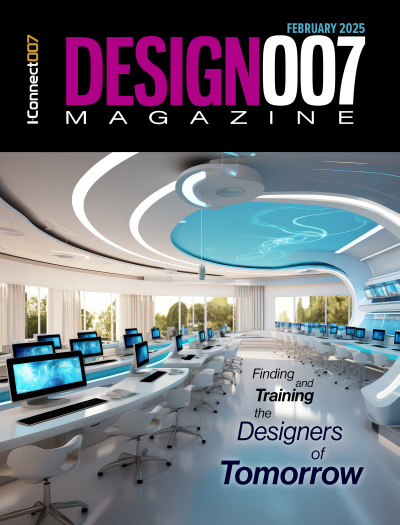-

- News
- Books
Featured Books
- design007 Magazine
Latest Issues
Current Issue
Designing Through the Noise
Our experts discuss the constantly evolving world of RF design, including the many tradeoffs, material considerations, and design tips and techniques that designers and design engineers need to know to succeed in this high-frequency realm.

Learning to Speak ‘Fab’
Our expert contributors clear up many of the miscommunication problems between PCB designers and their fab and assembly stakeholders. As you will see, a little extra planning early in the design cycle can go a long way toward maintaining open lines of communication with the fab and assembly folks.

Training New Designers
Where will we find the next generation of PCB designers and design engineers? Once we locate them, how will we train and educate them? What will PCB designers of the future need to master to deal with tomorrow’s technology?
- Articles
- Columns
Search Console
- Links
- Media kit
||| MENU - design007 Magazine
Advancements in Thermal Management: Material Talk With DuPont
February 6, 2025 | Marcy LaRont, I-Connect007Estimated reading time: 6 minutes
As our DesignCon coverage continues, this insightful discussion featuring Mike Kwasny, business development manager at DuPont™, delves into technologies and innovations in electronics manufacturing featuring their unique material solutions, including their Kapton® film and Pyralux® laminate lines.
Marcy LaRont: Mike, it’s good to see you. It is day two at DesignCon. The expo opened a few hours ago and I know you are seeing some solid booth traffic. Let’s talk about heat and materials. We are all dealing with a lot of heat. What has DuPont been up to in this area?
Mike Kwasny: DuPont has been doing a lot of exciting work in thermal management and these materials we're developing span our entire Interconnect Solutions business. Here at DesignCon, we are showcasing products from our Films business, our Laird business, and our Laminates business.
We have the Kapton MT and MT+ films, which have been around and remain an ideal solution for certain applications, both of which also have excellent electrical insulation. We're always working to push the boundaries and achieve even more thermal conductivity. We are actively working with customers to create better materials that contain the properties they’re looking for.
Similarly, on the Laminates side, we announced last year that we launched our Pyralux ML product, which is a heat-generating material for flexible heaters in medical, automotive, and other applications. Then, we are developing a thermally conductive laminate as well, which helps dissipate.
LaRont: The laminate side is attacking both giving heat if you need it or taking it away if you don’t. We don't talk about heat generation as much as heat dissipation but extreme cold is also a harsh environment for electronics.
Kwasny: One of the unique opportunities we have seen is in the automotive and EV spaces. Typically, you want to take heat out of the battery. But if you are in cold weather and you have an EV in the winter, these batteries don't last long. So, you actually may want to put some heat back into it to help the batteries work more efficiently and last longer. That's a unique opportunity for heat generation that you may not think about when having a thermal management conversation.
LaRont: I was in Chicago last year during a record cold front, and it was all over the news that EVs were dead on the sides of the road.
Kwasny: Yes, you hear a lot of those stories.
LaRont: Mike, I’m somewhat familiar with your Pyralux and your Kapton products used in flex circuitry. What is the Laird technology that you’ve partnered with for the Tgard™ product?
Kwasny: That's a really cool product. It's a collaboration between our Laird business unit and our films business unit, combining that Kapton MT+ films I mentioned with Laird's adhesive systems, as well as their processing capabilities to make parts.
We did this in a collaboration working directly with the customer who came to us saying, “We need something that has easy adhesion to the product that we're trying to develop, but also gets the heat out and maintains electrical insulation.” So, we worked together to identify what properties they needed and basically, how we could solve their problems. Through that collaboration with that customer, between Films and Laird, Tgard came out as a new product for the Laird portfolio, capitalizing on the thermal conductivity and dielectric strength of Kapton with the adhesive and parts manufacturing elements that Laird has.
LaRont: Wow, that is interesting and is just another example of how material science is evolving so rapidly right now.
Kwasny: Yes, we’ve got to push the boundaries every day.
LaRont: Can you elaborate further on specific market sectors and the problems that you are solving with these products?
Kwasny: I mentioned automotive batteries. That's an important segment where we're seeing big needs in thermal management, trying to put heat back in. But also, with the Tgard product, we get heat out of the batteries and keep them from overheating, which can also be a significant challenge in terms of thermal runaway in the batteries.
In terms of aerospace, these airplanes need to be in working order for decades, 20-30 years, and having too much heat in the circuits and the electronics of those airplanes will degrade them faster. They may not short out instantly, but they'll degrade faster over time. Having better thermal management in those electronics will help the airplanes to continue operating at peak function for a longer period of time.
The defense segment is another big area where the products face harsh and extreme environments. Warfighters go into every imaginable environment, whether it's deserts in the Middle East or extreme cold in the Arctic. The electronics need to function whether it's hot or cold, not overheating or getting too cold. They must keep that balance to function well, so the warfighters stay safe and complete their missions.
LaRont: It's pretty important stuff. That's for sure.
Kwasny: It's getting more important every day.
LaRont: Material technology and heat dissipation have got to be one of the hottest topics in electronics today, pun intended.
Kwasny: Yes, almost every customer we talk to says, “What can we do about heat? How can we get this heat out better? How can we manage this heat that we're seeing as we're trying to make our electronics stronger and more powerful?” More power creates a lot of heat.
LaRont: I attended a presentation this morning that said that the challenges of heat dissipation and thermal management with signal integrity and reliability requirements have created quite a puzzle for electronics manufacturers that just gets more and more difficult to solve.
Kwasny: Especially with AI and supercomputing. Yes, it is going to get increasingly difficult.
LaRont: Which is why it's great that DuPont has these products.
Kwasny: We're here to help.
LaRont: Mike, is there anything else you'd like to share?
Kwasny:, I would just say that DuPont is dedicated to being a good partner for our customers and helping them solve their problems. If customers are out there having problems with heat and they don't know what types of materials to use, you can talk to us. We'd be happy to work through it with you as we did with Tgard. We can develop new products to meet your needs.
LaRont: I know you work really closely with customers on R&D. I had the opportunity to visit your technology center last year, which was very interesting. It’s a live lab available to customers, which is a unique and important offering.
Kwasny: That’s a really good point. Our Sunnyvale Technical Center is based right near where DesignCon is happening and it is a full lab. We have all the capabilities and technical expertise there. We always welcome customers to come out, bring their parts, and let’s work through your challenges together. We help them find solutions and we can help them. We show the material seets we have the capabilities for testing and development, and other things like that to help them understand what they need and how our materials meet those needs.
LaRont: Mike, it's been good talking to you. This is interesting stuff. I will look forward to hearing more as new products develop.
Kwasny: Thank you, Marcy.
Sponsored Link: DuPont Industries & Applications
Suggested Items
Candor Elevates PCB Fabrication Services with Continued Facility Upgrades
04/28/2025 | Candor CircuitsOntario-based circuit board manufacturer, Candor Circuit Boards has recently completed a series of facility upgrades to improve their PCB offerings. These investments will allow Candor to provide higher volumes of complicated boards more efficiently with better yield. The new technology has allowed the company to take on exciting high technology projects and collaborations in industries such as Military and Aerospace, Medical, Energy and more.
Explore Thermal Management Solutions in Latest Podcast Series—New Episode Now Available
04/30/2025 | I-Connect007I-Connect007 is excited to share the latest episode in our new podcast series! In this episode, Ryan returns to discuss practical strategies for managing heat, starting early in the design planning and specification phases. After all, prevention means there’s less to mitigate later.
Transforming the Future of Mobility: DuPont Unveils Silver Nanowire Products in South Korea
04/17/2025 | DuPontDuPont will showcase its state-of-the-art products that incorporate silver nanowire technologies in Hall D, Booth A31 at Electronics Manufacturing Korea (EMK) and Automotive World Korea (AWK) exhibitions from April 16 to 18.
Saki’s AXI Upgrade Enhances Image Noise Reduction for Power Modules, Enabling Sharper, More Accurate Inspections
04/11/2025 | Saki CorporationSaki Corporation, an innovator in the field of automated optical and X-ray inspection equipment, announces significant enhancements to the image processing capabilities of its 3Xi-M200 X-ray Automated Inspection (AXI) system.
New Guide Offers In-Depth Look at Thermal Management in PCB Design
04/14/2025 | I-Connect007I-Connect007 is proud to release The Companion Guide to PCB Thermal Management, a must-have resource designed to complement NCAB’s popular podcast series. Created for engineers and PCB designers, this guide offers a comprehensive look at critical thermal management strategies essential for today's high-performance electronics.


